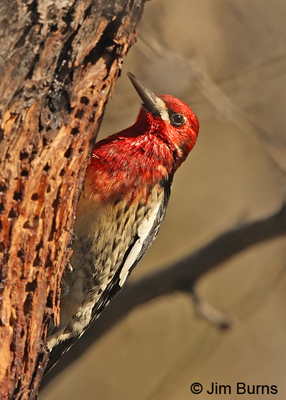
When I go to look for a specific bird reported at a specific site, I try to be inobtrusive and blend into the background until the bird gets comfortable with my presence. Let’s put it a different way. Could a stranger sneak into your living room without your being aware of their presence? Not likely. When I go specifically to photograph, I have the same mindset, with the additional thought that I have a problem to solve and I must do it as quietly and efficiently as possible.
Last weekend I was the first to arrive, about an hour after sunrise. I located the bird, discovered his favorite tree, but realized he was feeding in a circuit which took him away from the immediate area for anywhere from ten to thirty minutes. The next birder was a male, bins but no camera. He saw me, took a circuitous route around the area, and came in behind me. Turned out he was an old acquaintance. He stood still, right beside me, wearing neutral colors, we caught up with one another in whispered tones, the bird came in, he saw it, gave me a thumbs up and a pat on the back, and left the way he came. I’ll give him an “A.”
The second birder was a lady, bins, folding camp stool, and medium telephoto lens. I expected the worst, but she was the best. She came in like the man, avoiding the area of the favorite tree and circling around behind me. I discovered, all in whispereds tones, that she had been out every day that week to see the bird and had already gotten good photographs. She even pinpointed for me the bird’s favorite limb in the tree, then wished me luck and wandered off behind me to look for other birds—“A+.”
The next birder, a man carrying bins and a point-and-shoot with a short telephoto lens, walked in right by the favored tree. When he saw me with my long telephoto and tripod, he came over. In conversational tones he said he had already seen the bird earlier in the week but had only gotten poor photos. He wanted to get closer, but offered to stay back so as not to spook the bird for me. Then he starting telling me about all the other stuff he’d seen lately. I gave him a plus for his offer but minuses for his route past the tree and the constant conversation which was distracting both of us from the task at hand. I was praying he would stop talking, or at least lower his voice. “C.”
Then my worst nightmare arrived—a male birder with bins but no camera, loudly regaling us with his birding itinerary for the entire past week, replete with hits and misses, gesticulating with his hands, laughing, talking non-stop. I stepped about twenty yards away and tried to concentrate on watching for the bird of the morning while the other two one-upped one another with their travel experiences. Yeah, this guy gets an “F.”
The fifth and last to arrive was an elderly gentleman, a long, monopod mounted telephoto lens in one arm and in the other arm . . . a dog! No binoculars! No kidding! It was a “purse” dog, and the man set it down under his feet, its leash around his left wrist, and it never moved or made a sound. Okay, I’ll give the dog an “A.” Countless times, though, I’ve watched all the birds get out of Dodge the moment a dog arrived on the scene.
Our bird was back, playing hide and seek, staying behind the tree, then appearing in the sun suddenly and briefly, often behind intervening branches and twigs. Every time the bird came out, the dog’s master would “machine gun” it. I’ll hold the shutter down for flight and action, but why take multiple frames in less than ideal circumstances . . . unless you enjoy spending a lot of time in front of a computer instead of being out shooting. And I hate monopods, tippy and hard to balance with a telephoto unless you’re Brendon Grice. I left shortly, but the man with the dog rattled off 300 frames while I stood right next to him, seeing the same thing he saw, and took 17. Apparently just a photographer and not a birder, for his happy trigger finger and for mixing dogs and birds he gets an “F.”
Recently someone asked me if it was possible to photograph on a bird tour. Yikes! I told him no, not if he wanted good pictures. I know it sounds arrogant, but I want to see the birds well and get quality images—no bright clothing, no loud voices, no distractions.